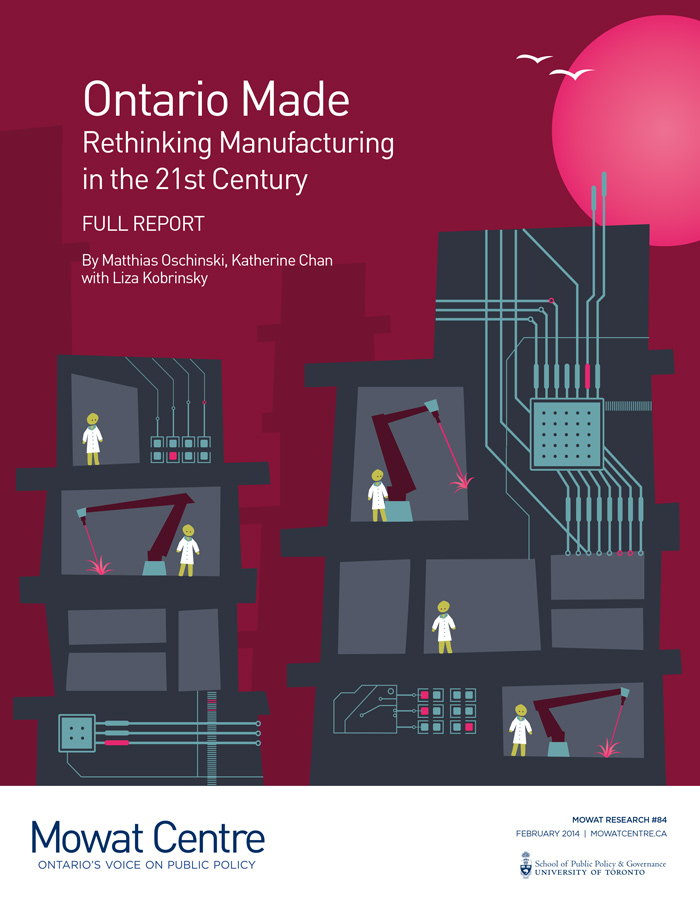

 Each year, governments in Canada spend roughly $20 billion combined on a variety of economic development, R&D, and innovation programs. While federal and provincial governments share responsibility for economic development, there is almost no formal coordination on how these programs and incentives are delivered. This Mowat Note takes lessons from other areas of shared responsibility to suggest a path forward for better alignment of these programs.
Each year, governments in Canada spend roughly $20 billion combined on a variety of economic development, R&D, and innovation programs. While federal and provincial governments share responsibility for economic development, there is almost no formal coordination on how these programs and incentives are delivered. This Mowat Note takes lessons from other areas of shared responsibility to suggest a path forward for better alignment of these programs.
This full report assesses the current state of the manufacturing sector in Ontario, explains why the sector has been facing challenges and outlines a practical strategy for renewal.
Over the past decade, manufacturing in Ontario has been challenged by fundamental changes in the global economy. First, the rise of emerging markets has led to more competition especially with respect to low cost industries such as textiles and leather. Second, increasing global trade resulted in the split of the value added chain in goods production. Where entire products used to be made in one location and subsequently traded in exchange for other goods, the new reality focuses on tasks along the value chain based on a country’s comparative advantage. Third, ongoing structural and technological changes lead to different requirements in talent and skills. Fourth, the rise in the value of the Canadian dollar eroded Ontario’s cost advantages and drove down its exports. Finally, the economic crisis in the United States, Ontario’s single most important export market, contributed to a sharp drop in demand for its manufacturing.
In the context of these challenges, the debate on whether manufacturing is still needed in advanced economies has divided economists in recent years. While some claim that manufacturing in developed countries is simply doomed and those concerned with the sector suffer from a “manufacturing fetish”, others point to manufacturing as an essential source of innovation and job creation.
This report aligns with the second point of view and argues that manufacturing is a key driver of economic growth and prosperity. Through its contribution to research and development (R&D), manufacturing is an important source of innovation. In addition, manufacturing has important linkages to other sectors in the economy. For instance, the Centre for Spatial Economics calculated that a $1 billion increase in manufacturing exports would generate an additional $805 million in manufacturing GDP and create around 7,779 new jobs in the sector.
Given manufacturing’s linkages to other sectors, it would also generate an additional $1.01 billion increase in GDP and raise employment by 8,776 in all other sectors combined. Moreover, manufacturing is a crucial source of export revenues. In Ontario, four of the top five international exports in 2011 were from the manufacturing sector. Finally, as manufacturing generally has higher levels productivity, wages in the sector are comparatively high as well. In Ontario, total hourly labor compensation in manufacturing has traditionally been higher than the average labor compensation of all other sectors. This, in turn, creates important fiscal benefits.
Within the new global framework, manufacturing itself is undergoing fundamental changes. New technologies and the Internet have facilitated new production processes, such as additive manufacturing, including 3D printing and cold spraying, digital manufacturing technologies, nano-manufacturing, bio-manufacturing and industrial robotics. These developments open up exciting opportunities for entrepreneurs and will change the manufacturing landscape over the medium term. In fact, many experts expect a new industrial revolution as a result of these technological changes. The impact of these advancements will be felt beyond manufacturing itself. As new technologies allow for more customization and decentralization, they will also influence consumer behaviour, logistics and business operations. With regard to the labour market, we will see a change in skill requirements as the production process shifts from linear, repetitive tasks to more sophisticated operations.
In principle, Ontario is well placed to take advantage of these new opportunities. Its highly trained workforce, competitive education system, well-developed infrastructure and tradition as a manufacturing powerhouse put it in an excellent position to stay at the forefront of this new industrial revolution.
Ontario’s technological clusters in Ottawa, Toronto and Waterloo have the capacity to bolster the movement toward “smart” hardware manufacturing. Traditional sectors now also have the opportunity to modernize their products and processes to remain competitive. Yet, to really seize the opportunities presented by new technological innovations, stakeholders need to respond to current challenges with a policy approach that cultivates Ontario’s global competitive advantage in high-technology manufacturing. This report contributes to that goal by analysing the current state of Ontario’s manufacturing sector vis-à-vis international peer jurisdictions to determine areas in need of improvement from a global competitiveness perspective.
Going further, the report establishes the underlying drivers of comparative advantage in high-technology manufacturing. Our findings show that the main measures to be taken in order to strengthen high-technology manufacturing in Ontario are: » Raising competitive pressure » Restructuring the regulatory environment » Breaking barriers to business through greater innovation » Fostering talent and skills
We then outline a targeted policy response in support of Ontario’s manufacturing future which builds on both Ontario’s comparative advantages in manufacturing and the province’s broader foundational advantages.
This report envisions Ontario’s manufacturing sector as one with the potential to excel in high technology, high value-added exports which would foster a highly productive, highly skilled and well-paid work force.
More information can be found in the links below:





